MarTech as the revenue engine
- Part 1 MarTech as the revenue engine
- Part 2Strategically using MarTech audits // Brandi Starr & Mike Geller — Tegrita
- Part 3Identifying Gaps & Overap in your MarTech stack // Brandi Starr & Mike Geller — Tegrita
- Part 4Choosing the right MarTech functionality // Brandi Starr & Mike Geller — Tegrita
- Part 5MarTech Implementation, Integration, & Optimization // Brandi Starr & Mike Geller — Tegrita
Show Notes
Quotes
-
“Thinking about revenue engine is going to be how your organization is driving revenue from where you are introducing your organization and its value proposition to the target audience to happily ever after when you have customers who are lifetime customers and advocates of your brand.” - Brandi“There’s an interesting trend happening in the MarTech industry where we are seeing sales and marketing being blended together more and I’m specifically talking about the B2B side. It’s doing something interesting to the KPIs for marketers where I think traditionally, we’ve all thought about customer acquisition, lead generation, and even lead scoring being really the most important metric that we’re thinking about.” - Ben “This is what we see as the future, not the siloed departments that are focusing just on whatever their charter is but rather a holistic team that is focusing on revenue and the customer experience.” - Brandi “We subscribe to the inbound methodology where you are looking at a tracked convert, closed, and delight as being the different stages. We really like this because it’s simplistic. When I go into different clients, they all have their different stages from awareness, to interest, to justify and they all have these different adjectives but at the core of it, things fall into four buckets.” - Brandi “It’s interesting because the tools go outside of marketing direct purview. If we’re thinking about the whole experience, if we’re thinking about the beginning through the end, marketing is involved throughout but other groups are involved as well. So the technology decisions cannot be made independently.” - Mike “So my takeaway is that there is a broader set of people in the organizations that are making approval decisions on MarTech purchases because they are being integrated beyond just the marketing efforts but they’re getting into sales automation and customer success. We’re all starting to work on a sort of unified system.” - Ben “Instead of thinking of the single piece of the pie in terms of customer experience the technology that the customer interact, we have to think about all the technology that the customer is interacting with.” - Mike “You get a much clearer view of what you’re trying to achieve, how are the tools working together, and to what purpose because you’re no longer looking at it from a siloed perspective. You’re looking at it from a larger group perspective so you’re able to see things differently and that’s something that hasn’t been possible in a silo-focused organization.” - Mike “Thinking holistically aligns the customer experience. The key here is if we get all of our team that touch revenue really focused on the customer experience and what that looks like for them.” - Brandi “If we’re able to leverage technology across all the phases, that’s digital in bringing people in, marketing to sales, to customer marketing to customer success. If we bring the technology for all of those departments together, to focus on a seamless customer experience that really puts customers’ interests and needs first, the revenue just naturally happens.” - Brandi “In B2B especially, there is a buying committee. There are different people that have different stakes in whatever that buying decision is. If you are able to leverage technology to understand who those people are that are involved in the buying committee, to leverage digital body language to understand what they are doing either on your website or interacting with your content or even being able to get intent data and other information on an aggregate level about the company then you are going to be able to put the right content and information in front of them prior to them actually interacting with someone at your company.” - Brandi “I think you bring up a good point in terms of the analytics and understanding intent. To me, the value of the MarTech stack in this unified version, whethere we’re merging marketing all the way through customer success, or we’re just building a system where the data can flow through quickly, is that the marketers today, using an efficient MarTech stack have the ability not just to look at what leads converted and what sources where it drove the lead conversion, they understand the conversion data and the value of those leads so we are able to market back to people that are maybe not the highest percentage of conversion but the highest value of a conversion.” - Ben “That, to me, is where we are actually building a revenue engine where I’m focusing my marketing efforts on what’s going to drive the most dollars not what is the most likely to convert to a lead who is not worth anything.” - Ben “It goes into the marketing philosophy that I learned, you need to focus and understand what’s happening at the bottom of your funnel first before you can really master the top of your funnel. This is why a unified system that allows your data to seamlessly flow through from acquisition all the way through lifetime value conversion is really important. You’re able to look and analyze who is converting and understand what the buying cycles look like, understand the rationale for them, and once you understand that, then you can market to people that look like them.” - Ben
- Part 1 MarTech as the revenue engine
- Part 2Strategically using MarTech audits // Brandi Starr & Mike Geller — Tegrita
- Part 3Identifying Gaps & Overap in your MarTech stack // Brandi Starr & Mike Geller — Tegrita
- Part 4Choosing the right MarTech functionality // Brandi Starr & Mike Geller — Tegrita
- Part 5MarTech Implementation, Integration, & Optimization // Brandi Starr & Mike Geller — Tegrita
Up Next:
-
Part 1MarTech as the revenue engine
This week we're talking specifics about how to use MarTech tools and strategies to put more money in your business's pockets. Joining us today are Brandi Starr and Mike Geller, the COO and the President and CTO at Tegrita, which is a full service MarTech consulting firm that enables digital marketing strategy with technology. In part 1 of our conversation, we discuss MarTech as the revenue engine.
-
Part 2Strategically using MarTech audits // Brandi Starr & Mike Geller — Tegrita
We continue our conversation about using MarTech tools and strategies to put more money in your business's pockets. Joining us again today are Brandi Starr and Mike Geller, the COO and President and CTO of Tegrita, which is a full service MarTech consulting firm that enables digital marketing strategy with technology. In Part 2 of our conversation, we discuss strategically using MarTech audits.
Play Podcast -
Part 3Identifying Gaps & Overap in your MarTech stack // Brandi Starr & Mike Geller — Tegrita
Today we're going to talk about using MarTech tools and strategies to put more money in your business's pockets. Joining us today is Brandi Starr and Mike Geller, who are respectively, the COO and President and CTO of Tegrita, which is a full service MarTech consulting firm that enables digital marketing strategy with technology. In part 3 of our conversation, we discuss identifying gaps and overlap in your MarTech stack.
Play Podcast -
Part 4Choosing the right MarTech functionality // Brandi Starr & Mike Geller — Tegrita
Today we're going to talk about using MarTech tools and strategies to put more money in your business's pockets. Joining us today is Brandi Starr and Mike Geller, who are respectively, the COO and President and CTO of Tegrita, which is a full service MarTech consulting firm that enables digital marketing strategy with technology. In part 4 of our conversation, we discuss choosing the right MarTech functionality.
Play Podcast -
Part 5MarTech Implementation, Integration, & Optimization // Brandi Starr & Mike Geller — Tegrita
Today’s episode talks about the process of implementation for your martech tools, how to create a focal point for your disparate tools to build a seamless integration, and how to optimize the martech stack you’ve built and make it function like a well-oiled machine. This is our last episode for Revenue Growth Week with our special guests from Tegrita.
Play Podcast











